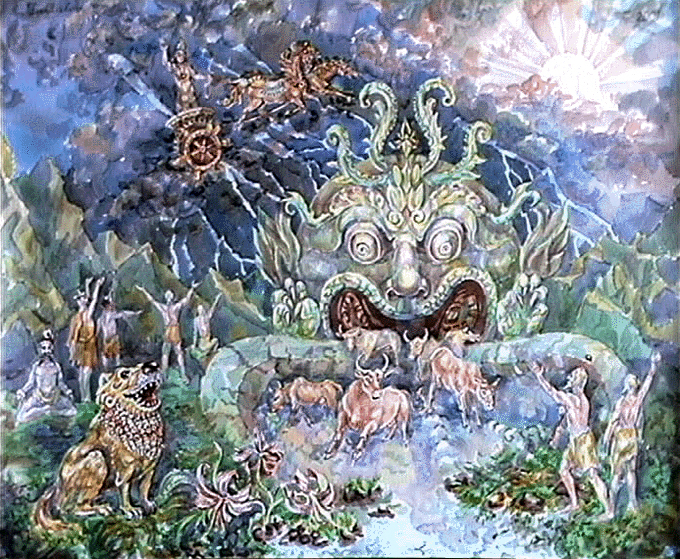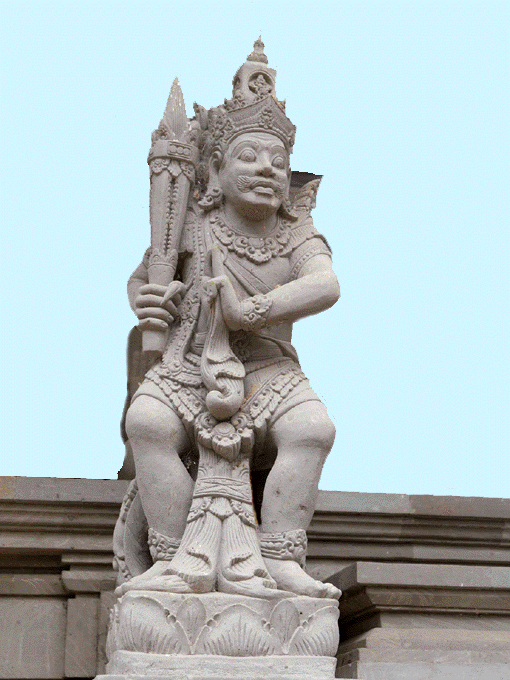Vritra and Vala, Part Four
BY: SUN STAFF

Indra Shakes Vala's Cave
Painting by A. Fantalov
Feb 16, 2014 — CANADA (SUN) — A serial study of the asura brothers, Vritra and Vala.
Vritra's brother Vala, also an enemy of Lord Indra, is mentioned in both the Rg Veda and Atharva Veda. The names of the demon siblings are thought to be derived from Varuna: val / var meaning "to cover, to enclose". In the case of Vrtra, the Sun was covered and the river's free passage was blocked. (Vrtra is also read as "the blocker".)
In the case of Vala, the cows and the Ushas were captured and enclosed in Vala's cave by the Panis, until they were liberated by Indra (associated with Brhaspati), aided by the Angirasas. In Rg Veda 2.24, Brahmanaspati is described as he who split Vala with prayer (brahman) rather than with a thunderbolt.
Usage of these Sanskrit terms and sastric references have been traced by historians to other cultures and languages, such as the Greek. For example, the Greek term 'triptolemos' is a variant of 'trigw-t-welumos', or 'terpsimbrotos', a compound term for 'cracker of the enclosure'. The Greek (w)elumos refers to the casings of grain, coming from the same root, wel. Thus in Greek literature, a rock or mountain, 'welos' or 'welumos' is split by a heroic deity (like Indra), liberating Dawn or the Sun.
In Udyoga Parva (IX) of the Mahabharata we find mention of Vritra's brother Vala, who was killed by Lord Indra even before he dispatched with Vritrasura. In defeating Vala, Indra was aided by the devatas:
"Then the nymphs said, 'O Indra, O slayer of Vala, we shall so endeavour to allure him that thou wilt have nothing to fear at his hands. That very receptacle of austerities, sitting now as if scorching everything with his eyes, O god, we are going together to tempt. We shall try to bring him under our control, and to put an end to your fears.'

Lord Indra
The Cave of Vala
The Cave of Vala, which plays a central role in Lord Indra's exploits with Vala, is described in the Rg Veda. Vala had concealed some cows in the mountain cave, along with Surya and the Ushas (the Sun and the Dawn), and Indra forcefully shook the cave to release them. In Rg Veda Mandala VI, Hymn 17, the hymns of Bharadvaja, Indra's liberation of the cows and Ushas from Vala's cave are mentioned:
RV 6.17.5-6:
Thou with thy wisdom, power, and works of wonder, hast stored the ripe milk in the raw cows' udders
Unbarred the firm doors for the kine of Morning, and, with the Angirases, set free the cattle.
RV 6.39.2:
Craving the kine, rushing against the mountain led on by Law, with holyminded comrades,
He broke the never-broken ridge of Vala. With words of might Indra subdued the Panis.
Vala is mentioned 23 times in the Rigveda, in the following hymns: RV 1.11, 52, 62; RV 2.11, 12, 14, 15, 24; RV 3.30, 34; RV 4, 50; RV 6.18, 39; RV 8.14, 24; and RV 10.67, 68, and 138. Among the central verses about Indra and Vala are the following:
2.12
Vala's cave
2.12.3
Who slew the Dragon, freed the Seven Rivers, and drove the kine forth from the cave of Vala, begat the fire between two stones, the spoiler in warriors' battle, He, O men, is Indra.
2.15.8
Praised by the Angirases he slaughtered Vala, and burst apart the bulwarks of the mountain. He tore away their deftly-built defences. These things did Indra in the Soma's rapture. [The Angirasas, a primeval families of seers who appear to have helped Indra in this endeavour.]
8.14.7
In Soma's ecstasy Indra spread the firmament and realms of light, when he cleft Vala limb from limb.
10.68.6
Brhaspati, when he with fiery lightnings cleft through the weapon of reviling Vala, consumed him as tongues eat what teeth have compassed: he threw the prisons of the red cows open.
1.11.5
Lord of the thunder, thou didst burst the cave of Vala rich in cows. The Gods came pressing to thy side, and free from terror aided thee,
1.32
Indra kills Vritra, the dragon Ahi. [Ahi is the personification of a glacier, frozen water destroyed by Indra to release the captive water.]
1.32.11
Indra smites Dasa and opens the caves where cows were imprisoned
1.62.4
Mid shout, loud shout, and roar, with the Navagvas, seven singers, hast thou, heavenly, rent the mountain; thou hast, with speeders, with Dasagvas, Indra, Shakra, with thunder rent obstructive Vala.
6.17.4-6
Indra after having consumed a few drops of Soma, burst the enclosures of the cave and shook it by its very foundation – a feat no human or God could have performed. The Sun and Ushas (Morning or Dawn) were released and thus, through his grace, that they obtained their splendour.
There is another pastime that took place between Indra and Vala, but this one does not involve the cave of cows. Garuda Purana (68) narrates the pastime:
"Sri Suta Goswami said: I shall now expound the science of gemology. Long ago, in ancient times, there lived a great demon name Vala. Overpowering the King of Heaven, Indra, Vala became the tyrannical ruler of the entire universe. By deceit, however, the oppressed demigods tricked Vala into acting as the sacrificial animal in a ritual performance. But once Vala was tied to the sacrificial stake, the demigods suddenly abandoned their mock sacrifice, and immediately killed the powerful demon. In fact, for the benefit of the demigods and the universe, Vala had allowed himself to be slain.
The demigods then severed his various limbs which transformed into the creative seeds of precious gems. As the potent body of Vala was dismembered, a tumultuous roar sounded through the celestial regions, and all the deities, demons, mystics, and serpent-gods anxiously rushed to gather up the gem seeds. The demigods clamored to secure the gem seeds, but the shock waves generated by their celestial chariots pushed some of the mystical essences down into the earthly sphere.
Some of these seeds fell into rivers, some into the oceans, and some into the forests and mountains. There they germinated as mother lodes of the various gems, each one imbued with its own intrinsic potency. All these gems posses talismanic powers. The fine, auspicious stones can counteract poison, snake venom, diseases, and other dangers. Poor quality, inauspicious gems act in the opposite manner.
Ruby, emerald, blue sapphire, cat's eye, yellow sapphire, diamond, pearl, hessonite, coral, bloodstone, quartz, jade, and red garnet are the foremost species of gems, and they should be selected only under the expert guidance of a learned gemologist.
The value of a gemstone is established by reference to the authoritative gemological texts. Quality is analyzed according to weight, cut, color, and clarity."
REFERENCES:
Rg Veda
Griffith, Ralph (1896), Hymns of the Rigveda
Wikipedia

